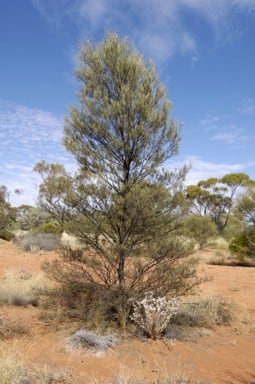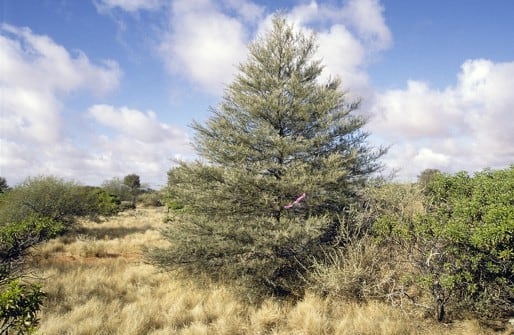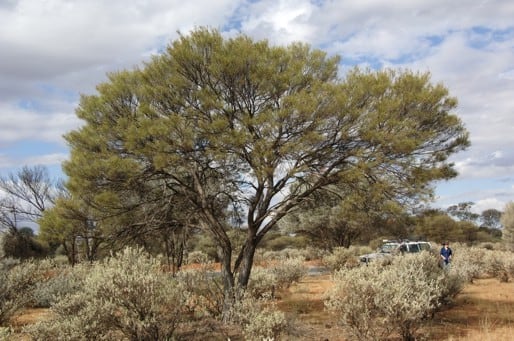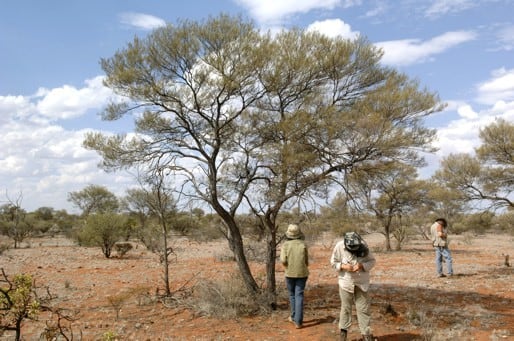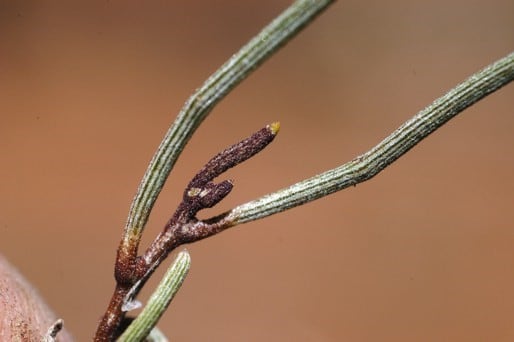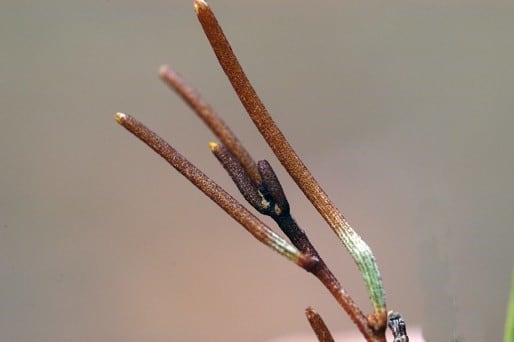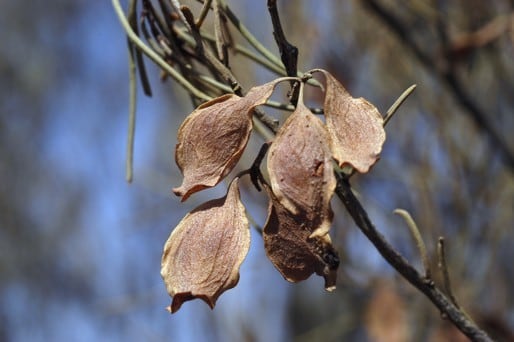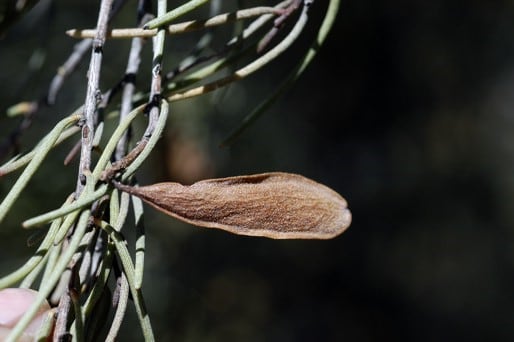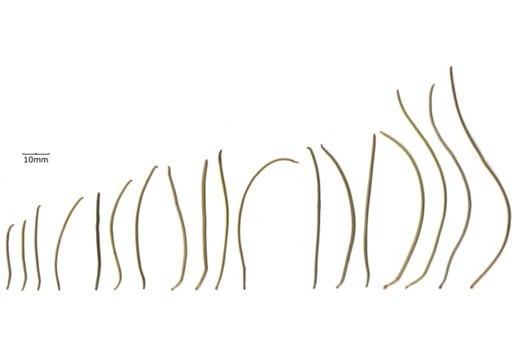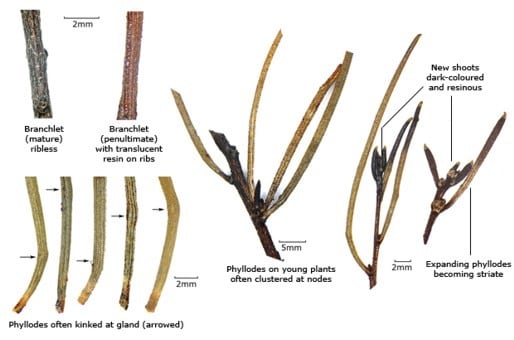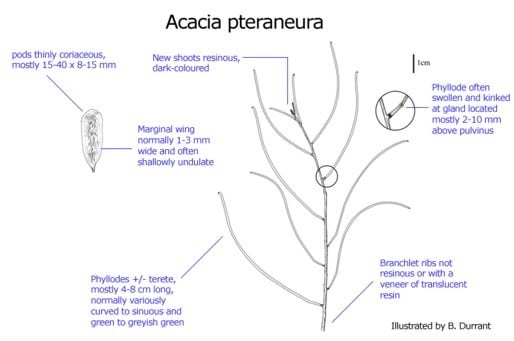Acacia pteraneura Maslin & J.E.Reid
WATTLE
Acacias of Australia
Family
Fabaceae
Distribution
Extends from near Gascoyne Junction S to Yalgoo in W.A., east to N.T. and S.A. (distribution in latter two states not properly assessed); in W.A. it is most common in the Murchison IBRA Bioregion.
Description
Shrub to 3 m high or tree to 6 (–8) m, sometimes with pseudo-conifer or rarely conifer growth form, trunks and main branches sub-straight to crooked. Branchlets often dark grey, hoary between the commonly red-brown, resinous or non-resinous ribs at extremities, soon glabrous, the resin translucent and normally forming a ±thin veneer; new shoots resinous, normally with a dense layer of dark-coloured glandular hairlets. Phyllodes mostly variously curved to sinuous or sigmoid, terete to subterete, rarely a few flat, 40–80 (–100) mm long, often shorter and in clusters of 2–5 on juvenile plants, 0.8–1.2 (–1.5) mm wide, normally green to greyish green, finely striate by longitudinal nerves with silvery appressed hairs between them (most obvious on young phyllodes); gland mostly 2–10 mm above the pulvinus, phyllode often swollen and/or kinked at the gland. Inflorescences simple; peduncles 7–15 mm long, with appressed white hairs and normally red-brown glandular hairlets; spikes 10–30 mm long. Flowers 5-merous; sepals ±free, linear to narrowly oblong and expanded at apex. Pods mostly oblong to narrowly oblong, flat, (10–) 15–40 mm long, usually 8–15 mm wide including wings, thinly coriaceous, openly reticulate, brown to greyish brown or reddish brown, glabrous or with minute, appressed hairs; marginal wing 1–3 (–3.5) mm wide, commonly undulate. Seeds normally oblique, 4–6 mm long, 2–3.5 mm wide; aril white or pale yellow.
Phenology
Flowering peaks in Apr.–May and July–Sept.
Habitat
Grows in a variety of habitats but commonly found on stony plains in red-brown sand, sandy loam, clay or sandy clay loam, often over hardpan; in open mixed Mulga shrubland or low woodland communities.
Specimens
W.A.: 23 miles [37 km] N of Warburton Mission, A.S.George 8191 (PERTH: pods narrower than normal); 29.5 km N of Meekatharra on Great Northern Hwy to Newman, B.R.Maslin 8007 (CANB, PERTH: coniferous growth form); Milly Milly Stn near intersection of Erong Springs Rd, 9.5 km W of Milly Milly Homestead, 0.3 km N of Byro-Milly Milly Rd, B.R.Maslin, J Miller & J.E.Reid BRM 9158 (AD, BRI, PERTH). N.T.: 49 km by rd W from Finke, S.G.Pearson SGP 260 (AD). S.A.: 9.4 km SE from Maryinna Hill (5.2 km direct ESE of Oompeinna Hill), P.J.Lang & H.P.Vonow BS23-24603 (AD).
Notes
See under A. paraneura for note on relationship with A. pteraneura.
Plants regarded as typical A. pteraneura have pods that are normally 8–15 mm wide with wings 1–3 mm wide, and phyllodes with the gland normally located 2–10 mm above the pulvinus. There are, however, some specimens with generally narrower pods (5–8 mm wide, with wings c. 1 mm wide) and with the gland (0–) 1–4 mm above the pulvinus. See B.R.Maslin & J.E.Reid, Nuytsia 22(4): 251–259 (2012), for discussion.
A member of the ‘A. aneura group’ (Mulga) most closely related to A. paraneura and A. fuscaneura (see these species for differences); also close to A. aneura which is most reliably distinguished by its flat phyllodes. Sometimes sympatric with A. aptaneura and terete phyllode forms of that species can resemble A. pteraneura but are distinguished by their non-winged pods and their phyllodes that are often straighter, less obviously swollen or kinked at the gland which is normally closer to the pulvinus, see B.R.Maslin & J.E.Reid, loc. cit., for further discussion. Putatively hybridizes with A. incurvaneura, A. aptaneura, A. fuscaneura and A. macraneura, see B.R.Maslin & J.E.Reid, loc. cit., for discussion.
Specimens of this species were cited by L.Pedley, Fl. Australia 11B: (2001), under both A. aneura var. microcarpa (= A. incurvaneura, viz. A.S.George 8191 and S.J. Forbes 1546) and A. aneura var. tenuis (= A. aptaneura, viz. B.R. Maslin 7074). While the type of A. aneura var. conifera is referable to A. pteraneura, further study is needed of the distinctive conifer and pseudo-conifer growth forms that occur in this and other species of the Mulga group, see B.R.Maslin & J.E.Reid, loc. cit., for discussion.
FOA Reference
Data derived from Flora of Australia Volumes 11A (2001), 11B (2001) and 12 (1998), products of ABRS, ©Commonwealth of Australia
Author
L.Pedley
B.R.Maslin
This identification key and fact sheets are available as a mobile application:
URL: https://apps.lucidcentral.org/wattle/
© Copyright 2018. All rights reserved.
